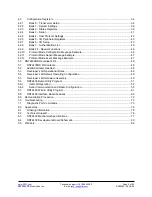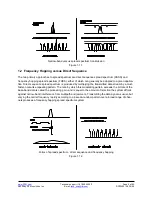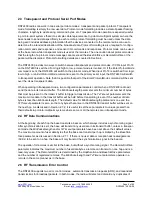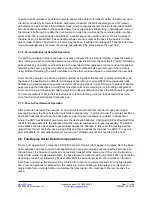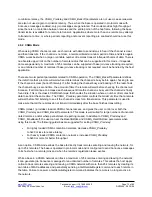
www.RFM.com
Technical s1.678.684.2000
Page 12 of 82
©2009 by RF Monolithics, Inc.
E-mail:
DNT2400 - 08/18/09
2.9 Channel Access
The DNT2400 provides five methods of channel access: one Polling, two CSMA, and three TDMA, as
shown in the table and figure below. The channel access method is selected by the AccessMode parame-
ter in Bank 1. See section 4.2.2. The channel access setting is distributed to all remotes by the base, so
changing it at the base sets the entire network. Polling refers to an application sending a command from
the base to one or more remote devices where only one remote device will respond at a time. Polling is
suitable for both large and small networks where unsolicited or event reporting by remotes is not required.
Carrier Sense Multiple Access (CSMA) is very effective at handling packets with varying amounts of data
and/or packets sent at random times from a large number of remotes. Time Division Multiple Access
(TDMA) provides a scheduled time slot for each remote to transmit on each hop. The default DNT2400
access mode is TDMA dynamic mode.
Access Mode
Description
Max Number of Remotes
0 Polling
unlimited
1 CSMA
unlimited
2
TDMA dynamic slots
up to 16
3
TDMA fixed slots
up to 16
4
TDMA with PTT
up to 16
Table 2.9.1
B a s e
R e m o t e # 1
R e m o t e # 2
R e m o t e # 3
T D M A
B a s e
R e m o t e # 1
R e m o t e # 2
R e m o t e # 3
C S M A
X
X
B a c k o f f
L i s t e n
L i s t e n
B a s e
R e m o t e # 1
R e m o t e # 2
R e m o t e # 3
P O L L
Figure 2.9.1
2.9.1 Polling Mode
Polling channel access is used for point-to-point and point-to-multipoint systems where only one remote
will attempt to transmit data at a time, usually in response to a command from the base.
Polling (mode 0) is a special case of CSMA mode 1. The user can set the BaseSlotSize and CSMA_
RemtSlotSize parameters when using this mode. Since only one remote will attempt to transmit at a time,




